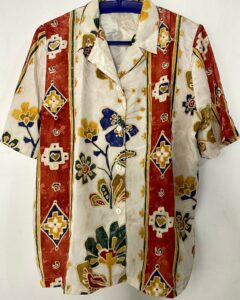Do you want your DTF prints to be more vibrant? Whether you’re a beginner or an expert at DTF printing, getting bright and colorful prints is crucial for creating high-quality designs. The film, ink, heat, and pressure parameters may affect DTF print brightness. In this blog article, we’ll discuss how to make DTF prints brighter. We will also see some typical problems that degrades print quality. So let’s get started.

Why is my DTF print not bright?
For DTF printing to produce high-quality designs, obtaining vivid and brilliant prints is essential. However, if your prints are not as bright as it should be, these are the possibilities:
- Film type: The film you choose affects DTF print brightness. Your prints will seem brighter and more vibrant if you use high-quality films with a brilliant white foundation.
- Quality of ink: The quality of the ink you use is an additional crucial factor that can influence the luminosity of your DTF prints. Your prints will be more vivid and dazzling if you use premium inks made especially for DTF printing.
- Heat and pressure settings: The DTF print brightness may be impacted by the heat and pressure settings you choose during printing. If the heat and pressure are too low, the ink may not adhere correctly, resulting in dull or fading prints. If the heat and pressure are too high, the ink may spread and dull the colors.
- Type and quality of substrate: The substrate you pick may affect the brightness of your DTF prints. For instance, printing on dark or multicolored substrates could need more layers of white ink to achieve the appropriate brightness. Additionally, using a top-notch substrate with no imperfections might help ensure that the ink adheres correctly and appears colorful and spectacular.
- Image Resolution: The design you are going to print on the garment should have a proper resolution. In general, 300 DPI is a good one to start with. If you choose a very low resolution image, the outcome won’t look bright. On the other hand, if you choose a picture that has very high resolution, it would increase the printing time. Hence, choosing the right resolution for DTF printing is very important.
How to Make DTF Prints Brighter?

- Use high-quality films and inks: Using high-quality films and inks made especially for DTF printing is one of the best strategies to get brighter DTF prints. High-quality inks make sure the colors are bright and vivid. High-quality films with a brilliant white base will help to enhance the ink’s brilliance.
- Adjust the heat and pressure parameters: As discussed before, the heat and pressure settings used during printing greatly affect DTF print brightness. Finding the perfect balance to produce the required brightness can be achieved by experimenting with various settings. Follow the manufacturer’s instructions carefully for the printer, film, and ink that you are using.
- Properly prepare the substrate to achieve bright, vivid prints. This involves properly cleaning and drying the substrate, using a high-quality primer if required. Also, remove any dirt or defects that may influence ink adherence.
- Use white ink as an underbase: Printing on dark or colorful surfaces using white ink make prints brighter and more vibrant. In this method, the white ink layer is printed first, then the colors are added on top. The white ink enhances the shades and gives them a brighter, more vibrant appearance.
- Print numerous layers: Printing multiple layers of ink could significantly enhance DTF prints. In order to use this method, you first print one layer of ink. After that, let it dry, and then print another layer on top of it. To get the required brightness and vibrancy, printing numerous layers may be necessary.
- Understand the technology and to practice printing to familiarize oneself with the equipment. This will help set realistic expectations for customers and allow for better communication with them.
Additional tips:
- Change the ink density: The brightness of the print may be altered by changing the ink density. Increasing ink density makes colors more bright and saturated, while decreasing it makes them lighter and pastel. Ink density impacts the ink drying time and ink adhesion. Thus, it’s vital to verify the settings before printing a significant quantity.
- Optimize the printing environment: Make sure the printer is in a temperature-controlled environment. It is crucial because changes in temperature might impact the viscosity and adherence of the ink. Dust and debris may also impair color clarity and brightness, so try to eliminate them in the printing area.
- Consider using a spot color: If you’re printing a design with particular colors, think about employing a spot color rather than only depending on the CMYK process. Spot colors are pre-mixed inks that provide colors that are more vivid and brighter than those created by the CMYK process.
- Examine the artwork before printing it and to ensure that the resolution is at least 300 DPI for better quality. [use a DTF gang sheet]
- Create neutral grays using only the K (black) channel, as opposed to using all four colors (CMYK), for better-looking final prints.
Practical Examples
let’s say you are printing a design with bright yellow and pink colors. The dark base color of a black t-shirt may muffle the colors of this pattern. The colors, however, would stand out and seem much brighter and more colorful if the same pattern were printed on a white t-shirt.
Choosing the proper clothing color may boost the brightness and vibrancy of your DTF prints and make the design seem its best. When choosing the ideal solution for each print, it’s crucial to take into account the color of the design and how it will interact with the garment’s base color.
DTF Color Setting (Basics)

You may follow a few basic recommendations to improve colors on your DTF Printer:
Color Mode: For correct color reproduction, change the color mode of your design file to CMYK. DTF printing employs CMYK inks, therefore designing in this mode help matching screen colors.
Color Profile: Use the right color profile for your printer and ink. You can find the suggested color profile in the printer’s manual or on the website of the ink supplier.
Ink Density: To get the required color intensity, change the ink density parameters. Higher ink density settings may yield brighter colors, but over-saturating the substrate can cause bleeding and smudge.
Print Resolution: Increase print resolution for clearer, more detailed prints. Remember that printing at higher resolutions takes longer and uses more ink.
Color calibration: To ensure that the colors are true and constant, calibrate your printer and display on a regular basis. This prevents color changes and keeps prints looking good.
Troubleshooting Common Issues
DTF print brightness and quality may suffer despite your best efforts. Following are some typical problems and solutions:
Faded or washed-out prints: Insufficient heat or pressure during printing cause DTF prints to fade. To determine whether the problem is fixed, try raising the heat and pressure settings and printing a test print.
Color that doesn’t stay the same: Color that doesn’t stay the same can be caused by a jammed printer. (Other reasons: not enough ink, or a problem with how the DTF ink is made). Try cleaning the printhead, making sure there is enough ink in the system, or determining if the ink is appropriate for the particular printer and film you are using.
Ink bleeding: Excessive heat, pressure, or ink composition may cause ink to bleed or spread. Reduce heat and pressure, use a different ink or substrate, or try alternative processes to get the desired outcome.
Poor ink adhesion: If the substrate isn’t prepared properly, the ink isn’t compatible, or the heat and pressure settings are too low, the ink won’t stick. To enhance adhesion, try properly prepping the substrate, utilizing a suitable ink and substrate, or increasing heat and pressure.
How to Fix Dull DTF Prints?

If the white ink in the DTF print appears dull, we have the solution. To fix it, the do some maintenance tasks such as clearing the ink and doing head cleaning. Set the color settings on the software. The setting should be on 200% white ink and 100% white under any color pixel.
After running the head cleaning, do the regular syringe maintenance and clean the syringe. Finally, put the syringe back and run the printer again, and you can see the difference in the print quality. The new print will look more vibrant, and there is no white backing. Even if you have done maintenance correctly, a simple head cleaning could make a big difference.
How to fix the transparent white ink problem?
How to deal with printer issues when it has been sitting idle for a few days, particularly when the white ink becomes transparent? We suggests doing a quick nozzle check before printing and do a nozzle clean if necessary. You can also use cleaning liquid and dropping it into the capping station if the printer is going to sit idle for a longer period of time.
Next, remove two white ink dampers that have become transparent and watery due to the ink’s tendency to separate. The dampers are connected to the ink tank via lines, and the white ink contains additives that prevent it from clogging.
Shake up the white ink and using a syringe to extract half of the syringe’s liquid and put it back into the white ink tank. Lastly, reassembles the dampers and turns on the printer to do a quick head clean. You can now observe the difference in print quality before and after the fix.
Conclusion
So, How do I make my prints more vibrant? Obtaining brilliant and vivid DTF prints requires careful consideration of a number of criteria, including choosing the appropriate fabric, using top-notch tools and ink, and maximizing heat and pressure settings.
You can make sure that your DTF prints look their best and stand out from the crowd by using the advice provided in this article. By addressing typical printing difficulties, you may overcome obstacles and accomplish your goals. With patience and experience, you can master DTF printing and produce gorgeous, eye-catching patterns.
FAQs
You can play with utilizing premium ink, adjusting the heat and pressure settings, and picking the proper clothing color to go with the design to make your DTF prints brighter.
Bright prints rely on the printing process and substrate. However, in general, premium pigment-based inks tend to provide the results that are the most vivid and durable.
Insufficient heat or pressure may cause washed-out or faded prints. To enhance the print, try tweaking the heat and pressure settings and doing a test print.
Various things, like a blocked printhead, a low ink supply, or a problem with the ink’s composition, might be the source of issues with variable color. Clean the printhead, make sure there’s enough ink, or try a new ink to see if that fixes the problem.
Excessive heat or pressure, ink composition issues, or employing a substrate not appropriate for the printing process might cause ink bleeding or spreading. Reduce heat and pressure, use a different ink or substrate, or try alternative processes to get the desired outcome.

Ashley Wang is a skilled sales manager with knowledge in DTF printing. She presently works for ShenLan Digital, a reputable DTF printer maker. Ashley is the best person to offer advice on selecting the most suitable DTF printer because she has tested a lot of them. She launched DTFPrinterSchool to educate individuals and organizations about DTF printing technology, providing her expertise and observations on the most recent advancements in the sector. Ashley is an invaluable resource for businesses and individuals wishing to invest in DTF printing technology because of her expertise and experience in the industry.
